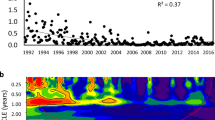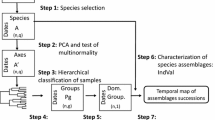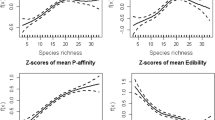Abstract
When looking for a pattern of phytoplankton behaviour across trophic gradients, we need to cross the boundaries between different disciplinary areas, from autoecology to systems ecology, because eutrophication is a complex process which involves different time scales and different levels of community structure. Thus, we submit our observations to the muddled conceptual world of assemblage ecology. These inaccuracies arise, for example, from both species and community arguments; eutrophication as a fertilization or a metabolic phenomenon; and the notions frequently interwoven of pattern, process and rules. We suggest that it is advantageous to tackle this issue from the perspective of general ecology, rather than from a specifically planktonic orientation. In this way, useful general ecological tools, for example, time series and assembly-rule studies, can be used. Time-series study allows the dynamics of any variable to be described or to show that long term variable fluctuations may sometimes be unregulated, in response to some exogenous factor. Rules of assembly help us to resolve which traits are selectively involved during the eutrophication process. In this context, we advocate (1) the use of traits instead of morphospecies in phytoplankton studies, (2) looking for the dynamic patterns of phytoplankton with eutrophication, (3) the use of time series techniques to study phytoplankton trajectories, (4) the use of assembly rules to discern patterns in the formation of multispecies assemblages, (5) the consideration of the pelagic food-web in studies of phytoplankton dynamics and, as an overall suggestion, to borrow knowledge and inspiration from general ecology.
Similar content being viewed by others
References
Allen, T. F. H. & T. W. Hoekstra, 1992. Toward a Unified Ecology. Columbia, New York: 384 pp.
Alvarez-Cobelas, M., M. Verdugo & C. Rojo, 1995. Time series of multivariate data in aquatic ecology. Aquat. Sci. 57(3): 185–198.
Alvarez-Cobelas, M., C. S. Reynolds, P. Sanchez-Castillo & J. Kristiansen (eds), 1998. Phytoplankton and Trophic Gradients. Developments in Hydrobiology 129. Kluwer Academic Publishers, Dordrecht, The Netherlands: 372 pp. Reprinted from Hydrobiologia 369/370.
Anderson, N. J., 1995. Temporal scale, phytoplankton ecology and paleolimnology. Freshwat. Biol. 34: 367–378
Begon, M., J. L. Harper & C. R. Townsend, 1996. Ecology. Blackwell Science, Oxford: 1068 pp.
Cappuccino, N. & P. W. Price, 1995. Population Dynamics. New Approach and Synthesis. Academic Press, San Diego: 429 pp.
Carpenter, S. R., J. A. Morrice, J. J. Elser, A. S. Amand & N. A. MacKay, 1993. Phytoplankton community dynamics. In Carpenter, S. R. & J. F. Kitchell (eds), The Trophic Cascade in Lakes. Cambridge University Press, Cambridge: 189–224.
Chatfield, C., 1984. The Analysis of Time Series. Chapman & Hall, London: 286 pp.
Drake, J. A., 1990a. Community as assembled structures: Do rules govern pattern? TREE 5: 159–164
Drake, J. A., 1990b. The mechanics of community assembly and sucession. J. theor. Biol. 147: 213–233.
Fox B. J. & J. H. Brown, 1993. Assembly rules for functional groups in North American desert rodent communities. Oikos 67: 358–370.
Harris, G. P., 1994. Pattern, process and prediction in aquatic ecology. A limnological view of some general ecological problems. Freshwat. Ecol. 32: 143–160.
Hastings, A., C. L. Hom, S. Ellner, P. Turchin & H. C. J. Godfray, 1993. Chaos in Ecology: Is Mother Nature a strange attractor?. Ann. Rev. Ecol. Syst. 24: 1–33.
Inouye, R. S. & D. Tilman, 1995. Convergence and divergence of old-field vegetation after 11 years of nitrogen addition. Ecology 76: 1872–1887.
Jassby, A. D., C. R. Goldman & T. M. Powell, 1992. Trend, seasonality, cycle and irregular fluctuations in primary productivity at Lake Tahoe, California-Nevada, U.S.A. Hydrobiologia 246: 195–203.
Lampert, W. & U. Sommer, 1997. Limnoecology. Oxford University Press, New York: 382 pp.
Likens, G. E. (ed.), 1987. Long-term Studies in Ecology. Springer-Verlag, New York: 214 pp.
Margalef, R., 1983. Limnologia. Omega, Barcelona: 1010 pp.
Mayr, E., 1982. The Growth of Biological Thought. Harvard University Press, Cambridge: 974 pp.
Peters, R. H., 1991. A Critique for Ecology. Cambridge University Press, Cambridge: 366 pp.
Powell, T. M., 1995. Physical and biological scales of variability in lakes, estuaries and the coastal ocean. In Powell, T. M. & J. H. Steele (eds), Ecological Time Series. Chapman & Hall, New York: 119–139.
Putman, R. J., 1994. Community Ecology. Chapman & Hall, London: 178 pp.
Putman, R. J. & S. D. Wratten, 1984. Principles of Ecology. University of California Press, Los Angeles: 388 pp.
Reynolds, C., 1990. Temporal scales of variability in pelagic environments and the response of phytoplankyon. Freshwat. Biol. 23: 25–53.
Reynolds, C., 1997. Vegetation Processes in the Pelagic: A Model for Ecosystem Theory. Ecology Institute, Oldendorf: 371 pp.
Reynolds, C. S., 1998a. What factors influence the species composition of phytoplankton in lakes of different trophic status? Hydrobiologia 369/370 (Dev. Hydrobiol. 129): 11–26.
Reynolds, C. S., 1998b. The state of freshwater ecology. Freshwat. Biol. 39: 741–753.
Rojo, C., 1998. Differential attributes of phytoplankton across trophic gradient: a conceptual landscape with gaps. Hydrobiologia 369/370 (Dev. Hydrobiol. 129): 1–9.
Samuels, C. & J. A. Drake, 1997. Divergent perspectives on community convergence. TREE 12: 427–433.
Sarnelle, O., 1996. Predicting the outcome of trophic manipulation in lakes. A comment on Harris (1994). Freshwat. Biol. 35: 339–342.
Schindler, D. W., 1990. Experimental perturbations of whole lakes as tests of hypotheses concerning ecosystem structure and function. Oikos 57: 25–41.
Seip, K. L. & C. Reynolds, 1995. Phytoplankton functional attributes along trophic gradient and season. Limnol. Oceanogr. 40: 589–597.
Scheffer, M., 1991. Should we expect strange attractors behind plankton dynamics and if so, should we bother? J. Plankton Res. 13: 1291–1305.
Sommer, U., 1990. Phytoplankton nutrient competition-from laboratory to lake. In Grace, J. B. (ed.), Perspectives on Plant Competition. Academic Press, Bristol: 198–213.
Sommer, U., Z. M. Gliwicz, W. Lampert & A. Duncan, 1986. The PEG model of seasonal succesion of planktonik events in fresh waters. Arch. Hydrobiol. 106: 433–471.
Sugihara, G. & R. M. May, 1990. Nonlinear forecasting as a way of distinguishing chaos from measurement error in time series. Nature 344: 734–741.
Talling, J. F. & S. I. Heaney, 1988. Long-term changes in some Rnghish (Cumbria) lakes subjected to increased nutrien imputs. In Round, F. E. (ed.), Algae and the Aquatic Environment. Biopress, Bristol: 1–29.
Taylor, F. J. R., 1993. The species problem and its impact on harmful phytoplankton studies. In Smayda, T. J. (ed.), Toxic Phytoplankton Blooms in the Sea. Elsevier Science Publishers, Amsterdam: 81–86.
Trifonova, I., 1988. Oligotrophic-eutrophic succession of lake phytoplankton. In Round, F. E. (ed.), Algae and the Aquatic Environment. Biopress, Bristol: 107–124.
Turchin, P. & A. D. Taylor, 1992. Complex dynamics in ecological time series. Ecology 73: 289–305.
Weither, E., G. D. P. Clarke & P. A. Keddy, 1998. Community assembly rules, morphological dispersion and the coexistence of plant species. Oikos 81: 309–322.
Weither, E & P. A. Keddy, 1995. Assembly rules, null models and trait dispersion: new questions from old patterns. Oikos 74: 159–164.
Wilson, J. B. & S. Roxburgh, 1994. A demonstration of guildbased assembly rules for a plant community, and determination of intrinsic guilds. Oikos 69: 267–276.
Wood, A. M. & T. Leatham, 1992. The species concept in phytoplankton ecology. J. Phycol. 28: 723–729.
Author information
Authors and Affiliations
Rights and permissions
About this article
Cite this article
Rojo, C., Alvarez-Cobelas, M. A plea for more ecology in phytoplankton ecology. Hydrobiologia 424, 141–146 (2000). https://doi.org/10.1023/A:1003969415868
Issue Date:
DOI: https://doi.org/10.1023/A:1003969415868




